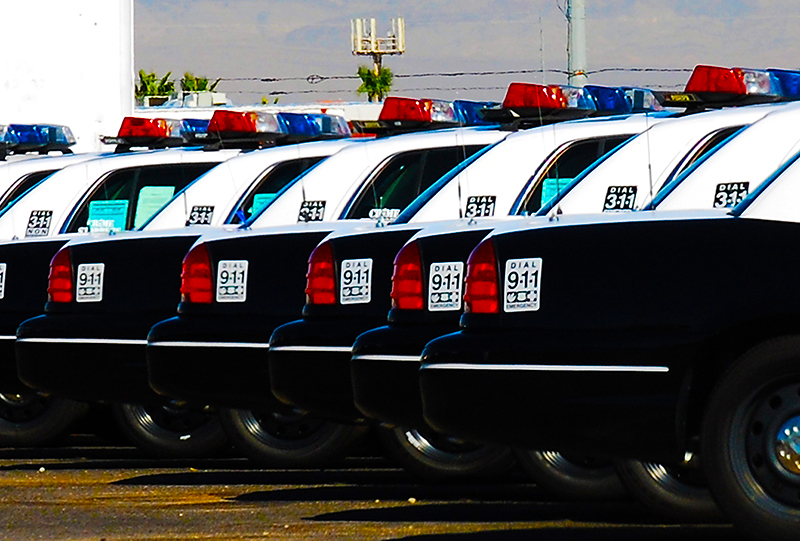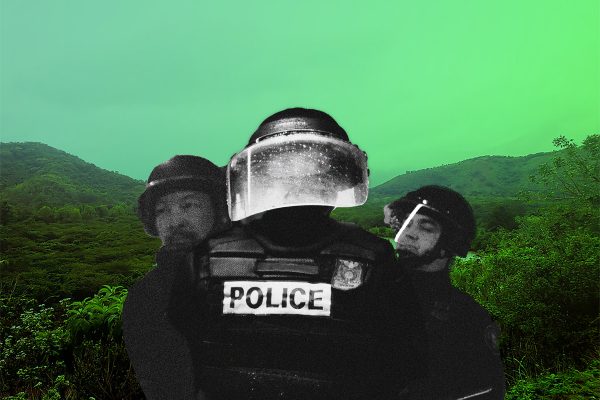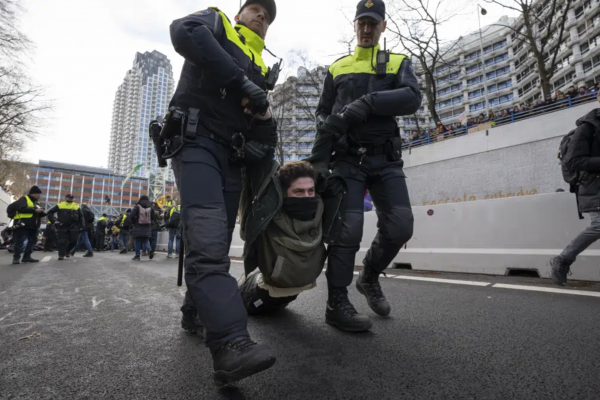On April 11, 1916, eight years after the Model T’s debut and just two years after the perfection of its moving assembly line, the Tucson, Arizona, sheriff’s office received a call around midnight about a robbery and assault at Pastime Park, a pleasure resort just north of the city. Three officers jumped into a “public service automobile” and, on their way to the scene of the crime, saw a car that seemed to be heading toward them suddenly turn around. Suspicious, they sped up to the car and yelled “Stop!” and “We are officers!” to no avail. Deputy Sheriff Thomas Johns testified that he then fired his pistol at the wheel “to puncture the tire.” He fired a second shot, Deputy Sheriff Joseph Wiley fired the third shot, and Police Officer Ramon Salazar followed with a fourth shot—all to “find out who the parties were in the car.” As it turned out, Captain John Bates and his wife, Mary, innocent parties, were driving home from a friend’s house. One of the shots struck and killed Mrs. Bates. All three officers faced murder charges.
The developments that led to the overpolicing of minorities did not originate with an intention to do so.
At trial, Captain Bates testified that his car was “very noisy” and the road “rough,” which could have described all motor vehicles and country roads at the time. The “chains which hold up the tailboard were rattling up and down on the fenders which are over each rear wheel; in fact, every time [he] hit a bump they would jump up and down; the muffler of the machine was wide open, and the exhaust [was] directly in front of the driver, underneath the footboard.” The driver of the public service automobile testified that his muffler was “wide open” as well. With all the racket that the cars were making, it was impossible for the Bateses to hear the officers’ shouts for them to stop. This, plus the fact of the Bateses’ actual innocence, convinced the jury that the three defendants had acted beyond their lawful authority and were guilty of murder. In the case of Wiley v. State, which affirmed the guilt of Deputy Sheriff Johns, whose shot had killed Mrs. Bates, the Arizona Supreme Court maintained that even if the Bateses had heard the shouts and refused to stop, the officers’ manner of pursuit “was more suggestive of a holdup by highwaymen than an arrest by peace officers.”
Police forces at the time were tiny compared to today, and officers shared the task of enforcing the criminal laws with citizens and private patrol services. Because private citizens also pursued, arrested, and prosecuted those who had injured or wronged them, the common law clearly circumscribed the right to arrest in order to distinguish a lawful seizure of a person from a kidnapping or assault. Legal requirements ensured that arrestees would know the exact reason for the apprehension. When Captain Bates and his wife were driving home that evening, they had no reason to believe, as the court noted, that officers, rather than highway bandits, were after them, firing away.
Recognizable police cars with black and white color blocks would not exist for another two decades, and the first revolving emergency light, the “Beacon Ray,” would not be invented until 1948. If police cars had any markings at all, they were either small signs attached to the front grill or the initials “P.D.” painted on the door—nothing that drivers could easily discern, especially at nighttime. As late as 1934, a consultant recommended that the police department in Dallas, Texas, paint its patrol cars “some unusual color, such as fire department red or bright yellow or perhaps with a fine grade of aluminum paint.” Without “definite identification,” his report warned of precisely what had happened to the Bateses: it was “not inconceivable that a frightened motorist thinking he is to be robbed may attempt to run away from officers, thereby creating a situation embarrassing and undesirable at its best and which may result in a serious accident or even in the officer, through mistaken identity, actually firing on and killing a reputable citizen.”
In the ruling for Wiley v. State, the court emphasized that officers had violated the “personal liberty of both Capt. Bates and the deceased,” who, “having committed no crime, were entitled to proceed on their way without interruption or molestation.” This presented a broad statement on the rights of drivers. Entitling them to proceed on their way without interruption or molestation necessarily included the corresponding right to decide for themselves whether officers had legal cause to stop them. If they decided that an officer did not, then they would have had the additional right to refuse to pull over. Indeed, the court made this exact suggestion when it stated hypothetically that even if “the Bateses had heard [the officers’] outcries and refused to stop, no inference of guilt could have been reasonably drawn therefrom,” a mandatory inference to justify an interference with the Bateses’ right “to proceed on their way.” The rules of the road according to the Arizona Supreme Court would have made it extremely difficult for officers to stop a car they found suspicious. This was the world of Wiley v. State, when the police were few in number, easily mistaken for highwaymen, and limited in their authority over innocent citizens.
A century later, on July 10, 2015, a Texas state trooper pulled over Sandra Bland for failing to use a turn signal. After a tense dialogue, the traffic stop quickly came to a violent end. The trooper first tried to yank the young black woman from the car before forcing her out with a Taser gun. He then arrested Bland, who was lying face down, crying, and screaming in pain. Three days later, Bland was found dead in her jail cell. A year later, the Nation published an article that asked the question that had become a viral hashtag, #WhatHappenedtoSandraBland? To find the answer, the article examined Bland’s life, beginning with her birth to a single mother in Chicago’s West Side. The answer, according to the writer, was not just the neglectful conditions in that Texas county jail that led to her death. The answer was also unemployment, insufficient mental health care, and draconian drug laws.
But another motif, never named, loomed throughout the article. The automobile appeared in nearly every significant setback in Bland’s life. Exorbitant traffic tickets that Bland paid for by “sitting out” in jail. Convictions for driving under the influence and arrest warrants for unpaid traffic fines that severely limited her employment options. Charges for possessing marijuana—her lawyer suspected that Bland was self-medicating—that the police discovered in her car. In Bland’s life, the automobile played a prominent role as a site of violence, poverty, and discrimination.
Before cars, police mainly dealt with those on the margins of society; voluntary associations governed everyone else.
The overpolicing of cars is a fact of life for people of color in the United States. Although Bland was not killed during the traffic stop, in 2015, the year of her death, 27 percent of police killings of unarmed citizens began with a traffic stop. Bland herself had been increasingly vocal on social media against police abuse and violence against African Americans, especially when the Black Lives Matter movement gained momentum after a police officer fatally shot eighteen-year-old Michael Brown. It turned out that what had happened in Ferguson, Missouri, on August 9, 2014, was part of a larger trend. The U.S. Department of Justice opened an investigation of the Ferguson Police Department and found “a pattern of unconstitutional policing” that skewed along racial lines. Most encounters with law enforcement, the report concluded, began with a traffic stop, an experience that disproportionately befell Ferguson’s black residents. In 2014 its municipal court had roughly 53,000 traffic cases, compared with about 50,000 nontraffic cases. This pattern was not limited to Ferguson. In their book In Context: Understanding Police Killings of Unarmed Citizens, scholars Nick Selby, Ben Singleton, and Ed Flosi concluded, “No form of direct government control comes close to [traffic] stops in sheer numbers, frequency, proportion of the population affected, and in many instances, the degree of coercive intrusion.”
What is the history that can account for the changes from Wiley v. State to Sandra Bland? Today, it would be improbable that Mrs. Bates, a wealthy white woman sitting in the passenger seat next to her influential husband, would be killed in a police shooting. Such tragedy now happens almost exclusively to minority drivers. Contrary to what one might expect, though, the social and legal developments that made the systematic policing of minorities possible did not originate with an intention to do so.
Instead, the shift began with the mass production of the automobile and the immediate imperative to regulate the motoring public. Before cars, U.S. police had more in common with their eighteenth-century forebears than with their twentieth-century successors. What revolutionized policing was a technological innovation that would come to define the new century. In the span of a century, towns and cities throughout the country—and not just in metropolitan centers—expanded their forces and professionalized beat cops, turning them into “law enforcement officers.” Figures are hard to come by, but one early report indicated that in the sixteen smallest states, the number of officers as a percentage of the population nearly doubled from 1910 to 1930.
Those who became subject to regular police surveillance included not just criminals in getaway cars but, more importantly, and for the first time, the respectable class of citizens who were the automobile’s early adopters. The need to discipline drivers and to do so without giving offense necessitated changes to the police function and to well-established laws. Officers now required discretion to administer the massive traffic enforcement regime and deal with the sensitivities of “law-abiding” citizens who kept violating traffic laws. The law’s accommodation of discretionary policing profoundly altered what it meant to live free from state intrusion in the automotive age. By the Cold War, U.S. society’s dependence on the police to maintain order raised troubling comparisons with totalitarian police. Unforeseen by midcentury jurists, their solution to the potential arbitrary policing of everyone led directly to the problem of discriminatory policing against minorities. Only by considering how U.S. society as a whole came to be policed can we more fully understand the history of our criminal justice and its troubled present.
Before cars, police mainly dealt with those on the margins of society. Voluntary associations governed everyone else. Churches enforced moral norms, trade groups managed business relations, and social clubs maintained social harmony. Citizens and private groups, including banks and insurance companies, pursued criminal investigations and initiated prosecutions. Aside from the constable or sheriff, who worked for the court and mainly executed warrants, publicly-funded police rarely took part in private enforcement efforts. A nineteenth-century treatise on the “duties of sheriffs and constables” indicates that the bulk of their work was to serve summonses, warrants, and writs, as well as to supervise prisoners. Large cities began establishing police forces in the mid-nineteenth century, but even so, municipal coffers did not support the extent of protection that wealthier neighborhoods and business districts sought. A system of “special policemen” licensed by the government but paid for by private citizens—private security, essentially—filled the void.
During the twentieth century, one of the most litigated issues was whether officers needed a warrant to stop and search a car.
This would all soon change when Americans embraced the “horseless carriage.” In 1910 the number of registered passenger cars was just under 500,000. That figure exploded to over 8 million in 1920 and to nearly 18 million in 1925—a thirty-fivefold increase in fifteen years. New regulatory and police practices soon developed to respond to cars’ mass adoption. Soon no one could drive without taking a test, applying for a license, registering the car, and buying insurance. And that was just the beginning. Once a person set out for a drive, speed limits, stoplights, checkpoints, and all the other requirements of the traffic code restricted how one could drive.
But towns and cities quickly ran into an enforcement problem: everybody violated traffic laws. Noncompliance was not a new phenomenon, but violations of the rules of the road presented a different quandary for two reasons. First, drivers included respectable people, and their numbers were growing every year. Second, traffic lawbreaking resulted in tremendous damage, injury, and death, and those numbers were increasing every day. It soon became clear that the public’s interest in street and highway safety required more policing.
This meant that everyone became subject to discretionary policing. The well-off were among the first to buy cars, as were farmers who needed cars for more practical reasons. Even if independent farmers may not have been as wealthy as the early auto enthusiasts, as a group, they enjoyed social standing in a country with a strong sense of agrarian virtue. Driving quickly became a middle-class, or what used to be called “business-class,” phenomenon by the mid-1920s, when car ownership passed a tipping point: 55.7 percent of families in the United States owned a car in 1926, and 18 percent of those had more than one. But even the rest of the population who did not drive and instead walked were policed, too, for the regulation of drivers on public streets also required the regulation of pedestrians on those same streets.
This completely transformed U.S. society. Law scholar James Willard Hurst found that by 1949, there were 119 “derivative effects of the auto upon the law.” Many of those effects’ connections to the rise of automobility are now largely taken for granted. Road trips, for example, informed no. 68 on Hurst’s list: “The hotel business, with new forms such as the tourist cabin grew, giving new importance to the law of innkeepers.” The necessities of manufacturing and retail appeared higher up on the list: “4. Legal devices for private economic planning—contract, franchise, parent-subsidiary corporation relationships—became important for ordering an industry that draws together diverse sources of supply.” Other effects’ ties to cars are still pressing, such as no. 39: “Conservation problems developed in connection with the oil industry.” Or familiar, as in no. 50: “It affected the extent and types of extra-legal sex relations through the privacy and mobility it afforded.” Scanning the list gives the impression that the automobile left no area of law, or everyday life, untouched. Cars radically changed daily lives and aspirations, culture and the built environment, and people’s relationships with each other and their communities.
Judges believed that the warrant requirement did not apply in the public sphere of the road.
This dramatic shift in policing created conundrums both profound and practical. How could a democratic society founded on self-governance depend on police governance and still be free? And how could laws be fashioned to allow the investigation of potential criminal suspects without harassing law-abiding citizens?
Because the first moment in a police encounter is a stop, otherwise known as a “seizure” of a person, which could then be followed by a “search,” the Constitution’s Fourth Amendment guarantee against unreasonable searches and seizures became the main provision governing this new regime of policing. During the twentieth century, one of the most litigated issues in criminal procedure was whether officers needed a warrant to stop and search a car. At stake in this legal question was the very legitimacy of discretion at the heart of police governance. Requiring officers to get a warrant from a magistrate would hold up their efforts to proactively investigate crime. Conversely, eliminating the warrant requirement would allow the police to act according to their own judgment. In adjudicating Fourth Amendment car cases, then, judges were, at bottom, redrawing the boundaries of legitimate policing.
The automobile served as the main setting for working out difficult questions about the police’s power not only because its mass adoption prompted a sea change in policing. It also undermined the public/private distinction, the cornerstone of nineteenth-century constitutional law. Cars were private property, which should have given individuals all the private rights attached to ownership and possession, including the Fourth Amendment requirement that officers have warrants for searches and seizures. But cars traveled on public roads and were subject to public rights, and early twentieth-century judges believed that the warrant requirement did not apply in the public sphere of regulation and policing. In a legal tradition that hewed to categorical reasoning, judges floundered in their attempts to protect both individual expectations of the private sphere and the public’s interest in orderly and crime-free highways. The need for police protection and protection from policing collided in Fourth Amendment car cases. Judges grappled with the warrant question precisely because robust police powers and equally robust ideas about the freedom of automobility had developed, paradoxically, in tandem.
Justice Louis Brandeis embodied this contradiction. He believed, more confidently than his associates on the Supreme Court, that officers had the constitutional authority to search ships on the high seas and cars on public highways without warrants. At the same time, his dissent in the 1928 case Olmstead v. United States marked the first appearance of the right “to be let alone” from government intrusion in a Supreme Court opinion. Within half a century, Brandeis’s “right to privacy” provided moral and legal authority for Griswold v. Connecticut, a 1965 case that established the fundamental right of married couples to use contraceptives, which, in turn, set off a series of cases staking rights to personal and sexual autonomy. How did Brandeis reconcile a far-reaching power to govern with a visionary right of privacy? This was the great struggle in the twentieth-century United States.
Examining twentieth-century car cases in state and federal courts reveals that Fourth Amendment jurisprudence evolved not just to limit police discretion, but also to accommodate it. This conclusion is at odds with most accounts of twentieth-century criminal procedure. The familiar story, in brief, goes something like this: Beginning in the 1960s, the Warren Court overthrew the traditional arrangement in which federal courts left local police matters to the states in order to protect minorities and the poor. What was so revolutionary about this was the judicial creation of a national standard of criminal procedure. Put simply, the Supreme Court began policing the police.
Rather than settling on a principle, judges deferred to the police.
But this standard narrative provides only half the story. In fact, U.S. courts did more to encourage and sustain, rather than to check, the growing authority of police. Scholars have tended to miss this by focusing only on landmark Supreme Court cases, such as Mapp v. Ohio (1961), in which the Court ruled that police had acted egregiously by forcing their way into a home without a warrant. But meanwhile, in thousands of car cases in which courts ruled in favor of police action, the judicial endorsement of greater discretionary policing became a settled matter. This was accomplished by shifting the focus of the courts’ attention: instead of deciding whether cars fell within the public or private sphere to determine whether stops and searches of cars, as a category, required warrants or not, judges chose instead to evaluate whether a particular car stop and search was reasonable. Even Brandeis, upon conceding that the right to privacy could ultimately be subject to the public’s interest, resorted to “the reasonableness or unreasonableness of an act” to determine the boundary between competing rights. The Wiley v. State right to drive “without interruption or molestation” was gone. Captain Bates would now have to pull over, but at least he would be dealt with reasonably.
But it proved difficult to pin down a definition of reasonable policing, let alone flesh out a coherent theory for determining reasonableness, when patrolling the byways and highways presented a myriad of unexpected situations and often involved split-second decision-making. What jurisprudential philosophy could both enable and limit police discretion? Rather than settling on a principle, judges deferred to the police. When faced with the exigencies of automobility—and especially when those caught red-handed, not the wrongly suspected, were typically the ones who brought Fourth Amendment challenges—judges tended to side with order and security and conclude that zealous and intrusive police action for the sake of the public welfare was reasonable and did not compromise the values of a democratic society. In case after case, throughout the country and through the decades, courts concluded that the police had acted reasonably. Every now and then, an individual defendant won. But far more often, reasonableness functioned as a deferential standard. This deference, in turn, gave the police even more power.
But the Court’s revolutionary decisions left an opening for an insurgency, even if ultimately ill-fated. Increasing numbers of criminal defendants invoked the new rights established in home invasion cases and disputed the reasonableness of police action, forcing courts to mediate their encounters with police. Over time and without a consistent method or principle, all the individual reasonableness determinations accumulated into judicial rules, which became more numerous, more specific, and more complex. Scholars refer to the body of laws accrued from legal challenges against the police as “the modern regime of criminal procedure.” These laws are procedural in the sense that they direct how the police should police, unlike substantive rights, which secure the right to be free from government, including police, intrusion.
In truth, more significant than the choice between substance and procedure was the decision over how Americans would govern themselves. Because substantive rights would have greatly limited the discretionary policing that the “law abiding” wanted, minorities and the poor instead received rules regulating the police’s ever-growing power. The upshot, as time would tell, was not the protection of individuals’ privacy in their cars but the empowerment of highway patrollers and traffic cops who could take advantage of the thicket of procedures to exercise their power in discretionary, even discriminatory, ways. This was the legacy of the Fourth Amendment from the Automotive Age.
Excerpted from Policing the Open Road: How Cars Transformed American Freedom by Sarah A. Seo, published by Harvard University Press.








